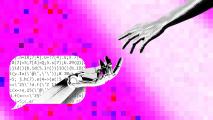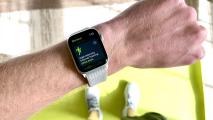In February 2021, Conor was in his room and looking at his phone when he was struck by a strange feeling.
“The room looked normal, nothing was moving, but I felt as though I was under the influence of a psychedelic,” he told Big Think.
As a teenager, Conor had experimented with LSD, mushrooms, and other psychedelics a couple dozen times. He was now 25 and had been sober for about a year. He brushed off the incident.
But soon Conor was struck again by the same sensation.
“I had no idea what was going on in my brain at that time and the anxiety and paranoia grew so intense that I became fearful I had developed everything from brain cancer to schizophrenia,” he said.
The physical and psychological symptoms he began suffering were “devastating.”
“The world [looked] crooked and out of focus, pictures had an eerie quality to them, things would go in and out of focus, at night while falling asleep I would experience vivid and terrifying hypnagogic hallucinations that made rest impossible.”
After three weeks, Conor said his visual symptoms amplified with “unbelievable intensity.”
“The floors would [breathe], paint on the walls looked wet, visual snow was so intense [that] pure black looked like it was glowing, at night I would see tracers everywhere, halos appeared around text. […] I did not sleep, my thoughts were anxious and at times deranged, I had unbelievably intense dereliction that made the world seem fake.”
To Conor, it soon became clear that he was suffering from hallucinogen persisting perception disorder (HPPD), a rare and poorly understood condition in which people experience omnipresent or recurring flashbacks.
LSD flashbacks
A flashback is a mysterious phenomenon in which someone who has previously taken a hallucinogenic drug suddenly and temporarily experiences the effects of that drug days, weeks, or even years after consuming it.
Flashbacks can occur after taking a wide range of psychedelic drugs. But compared to other hallucinogens, flashbacks seem to be most common among people who have consumed LSD.
People have reported acid flashbacks for decades. The earliest recorded case may be Havelock Ellis’ 1898 report of taking mescaline and later experiencing sustained and heightened sensitization to “the more delicate phenomena of light and shade and color.”
But it wasn’t until the 1950s, little more than a decade after Albert Hoffman first synthesized LSD, that scientists started researching LSD and its potential long-term effects. While studies have illuminated some aspects of how psychedelics affect the brain, scientists still have much to learn about the nature of LSD flashbacks, what causes them, and how to treat them.
What’s certain, however, is that a small percentage of people who consume psychedelics report bizarre and sometimes debilitating effects that emerge long after taking hallucinogens.
Symptoms of LSD flashbacks
Among the most common symptoms of LSD flashbacks are visual distortions. In a 1983 study titled ” Visual Phenomenology of the LSD Flashback,” the psychiatrist and LSD researcher Dr. Henry David Abraham described 16 common visual disturbances reported by people with LSD flashbacks. To name a few:
- Acquired color confusion: The color of objects changed or presented a newly discovered problem of color confusion.
- Difficulty reading: Text may appear jumbled or leave afterimages of the type against the background of the page.
- Geometric phosphenes: Phosphenes, or eigengrau, are non-specific luminous perceptions that occur when the eyes are closed and may originate from entopic (i.e., arising from within the eye itself) stimuli in normal persons. They also may be induced by gentle pressure on the closed eyelid.
- Pareidolias: This is literally an image within an image. These were described when a subject gazed into a finely reticulated design in linoleum, veneer, or a cloud formation. Besides the abstract pattern of the linoleum, subjects often would be able to see a series of concrete images as well, such as “a fish,” “a face,” and “a little boy.”
- Macropsia: Macropsia is the perception of an object larger than it really is. A characteristic description of this phenomenon came from a subject who noticed that his hand was enormous and then of normal size a few seconds later.
- Micropsia: Micropsia is the perception of an object smaller than reality. One subject said, “My feet looked so tiny, like they were a million miles away.”
The effects of LSD flashbacks aren’t limited to visual distortions. In a 1970 study called “Analysis of the LSD Flashback,” researchers sorted LSD flashbacks into three broad categories: perceptual, somatic (meaning of the body), and emotional.
The emotional flashback is “far more distressing” than the other two, the researchers wrote, providing a case study of a 21-year-old woman who was suffering from LSD flashbacks:
“The patient had these frightening flashbacks during the day, while walking down the street, after smoking marijuana or drinking wine, during the night, and occasionally even while asleep. In one situation she awoke during the middle of the night with a feeling of panic and began running around her house fleeing an imagined threat she could not identify or comprehend. She had taken LSD a number of times, but her last few trips were bad ones with panic and fright followed by loneliness to the point of suicidal despair when she ‘came down.’ The combination of bad trips and emotional flashbacks made her seek professional help because of her fear that she would harm herself.”
To be sure, LSD flashbacks aren’t always emotionally distressing. A 2010 survey of 600 hallucinogen users found that, of the minority of users who reported experiencing at least one flashback, only 3 percent described it as a negative experience. In fact, some people enjoyed their flashbacks. On the website Erowid, which promotes research of psychedelic drugs, one user wrote:
“After 2 years of my last acid trip, while on vacation in a very nice wilderness place I was sitting on a rock and then I experienced a clear acid high. I was looking at a very steep hill and suddenly it started moving in nice patterns, exactly as one sees patterns while on acid. It wasn’t something uncomfortable. In fact it was really pleasant and there was absolutely no trace of the nasty anxiousness after effects common to LSD. It lasted approximately 2 minutes and I enjoyed it very much.”
But some LSD flashbacks are neither brief nor pleasant. A subset of people who use psychedelics develop HPPD. While the symptoms of HPPD vary, the condition can cause intense pain, irreversible perceptual distortions, emotional and psychological distress, and even suicidal thoughts.
What is HPPD?
HPPD is estimated to affect between one to five percent of LSD users, though the actual figure is impossible to determine without better data. The disorder was first described formally in 1986 by the American Psychiatric Association’s Diagnostic & Statistical Manual of Mental Disorders, 3rd edition, revised (DSM-III-R). The current edition of the manual (DSM-5) says patients need to meet several criteria to be diagnosed with HPPD:
- Patients must reexperience perceptual symptoms they experienced while intoxicated with the hallucinogen.
- These symptoms must cause “significant distress or impairment in social, occupational, or other important areas of functioning.”
- These symptoms aren’t due to a separate medical condition or mental disorder.
So, what’s the difference between a flashback and HPPD? Mainly frequency and duration. A 2017 review published in Frontiers in Psychiatry noted that while “a flashback is usually reported to be infrequent and episodic, HPPD is usually persisting and long-lasting.”
A 2014 review published in the Israel Journal of Psychiatry and Related Sciences outlined two types of HPPD. The first, HPPD I, is the “flashback type,” which is a generally short-term, non-distressing, benign and reversible state accompanied by a pleasant affect. The severity of HPPD I varies, with some people describing their mild flashbacks as annoying, while others say it’s like getting “free trips.”
But HPPD II is a different beast. The condition can be permanent, with perceptual distortions and other symptoms manifesting irregularly or almost constantly.
“The symptoms usually include palinopsia (afterimages effects), the occurrence of haloes, trails, akinetopsia, visual snows, etc.,” according to the aforementioned 2017 review. “Sounds and other perceptions are usually not affected. Visual phenomena have been reported to be uncontrollable and disturbing. Symptomatology may be accompanied by depersonalization, derealization, anxiety, and depression.”
What causes flashbacks and HPPD?
When asked what causes flashbacks and HPPD, Dr. Abraham told Popular Science, “I’ve spent my life studying this problem and I don’t know, is the short answer.”
But researchers have proposed explanations. One centers on memory. Because psychedelics can cause extremely powerful and emotional experiences, it’s theoretically possible that certain environmental stimuli can remind people of those experiences, and then memory “transports” them back into that subjective mindset — similar to how a soldier with post-traumatic stress disorder might suffer an episode after hearing a loud, sudden noise.
Another hypothesis involves how LSD interacts with the brain’s visual processing center. Dr. Abraham proposed that HPPD may arise due to “disinhibition of visual processing related to a loss of serotonin receptors on inhibitory interneurons,” which may be caused by consuming LSD.
The basic idea is that LSD somehow changes the way the brain interprets visual stimuli. That might explain why people with HPPD have difficulty properly “disengaging” from the things they see around them. For example, a red stoplight might appear not as a discrete red circle but as a streak of red light painted across their field of vision; or a strobe light might not appear as a flickering light but a light that’s constantly on.
“Such a locking of visual circuitry into an ‘on’ position following perception of a visual stimulus would explain such diverse complaints as trailing, color intensification, positive afterimages, phosphenes, and color confusions, each of which may represent a failure of the respective visual function to turn off the brain’s response to the stimulus once the stimulus is gone,” Dr. Abraham wrote.
It’s also possible that people are genetically predisposed to HPPD and that ingesting LSD is the key that unlocks the disorder. This hypothesis would help explain why people have reportedly developed HPPD after taking a single, moderate dose of LSD.
Ultimately, the exact causes of HPPD are unclear. Partially as a result, there’s currently no cure for the disorder, though studiesshow that people with HPPD have reported improvements in symptomatology after taking benzodiazepines. There’s also anecdotal evidence that fasting can alleviate the disorder.
Despite uncertainty over the causes of HPPD, researchers do have a good idea of what can trigger “flare-ups” of HPPD. Dr. Abraham’s 1983 study listed the most common triggers, some of which include:
- Emergence into a dark environment
- Intention (intentionally inducing visual aberrations by, say, staring at a blank wall)
- Marijuana
- Phenothiazines
- Anxiety
- Fatigue
People with HPPD describe the condition
To get a better understanding of HPPD, Big Think posted a questionnaire to the HPPD community on Reddit. Here are some of the responses:
How did HPPD first manifest for you?
IBeatMyGlied wrote:
“First I noticed highly enhanced creativity and intense visuals when [high on] weed and I really enjoyed that part. The realization that this is not going to go away soured the whole experience tho.”
“My enhanced creativity left me after about a week and what I was left with was mild visual snow. I hardly knew anything about HPPD at the time and just didn’t really care about my symptoms and still thought they were just going to vanish at some point, which they didn’t. I kept taking drugs simply because I was addicted and felt like life is no fun without them. My HPPD got gradually worse over time and more symptoms appeared. First, I noticed mild tracers, which got worse over time (again due to continued drug use) and then tinnitus and brain fog. But primarily my symptoms are visual.”
Are your symptoms episodic or constant?
“Both constant and episodic,” wrote user LotsOfShungite. “A stressful event can trigger my symptoms off into the deep end.”
Halven89 wrote:
“Except the brain fog and head pressure that varies, my visual disturbances are constant. The most debilitating ones are the visual snow, especially when I’m inside except if I watch the TV since it filters some of it out. It’s also VERY frustrating that I no longer can focus on objects/details (can’t stare) and the astigmatism-like symptoms that I got, like blurriness, especially in the distance and ghosting (double vision) plus starbursts from strong light sources. When I’m outside, the pattern glare is really annoying, same with the excessive amount of floaters that came with this. I also see halos from light sources.”
IBeatMyGlied wrote:
“My symptoms are mostly constant and only change through rather obvious outside influences, such as certain drugs (almost all drugs), stress, lack of sleep, etc. Although my HPPD is quite pronounced, I have learned to accept it and almost only notice it when I pay attention to it. I always [know] it’s there and it somewhat bugs me but I get along.”
What are some common misconceptions about HPPD?
Conor said:
“I think the most common misconception about hppd is when people refer to it as “tripping permanently”. There is a massive distinction between those two things. Generally with hppd, your vision may be altered, but to call it “tripping” is incredibly misleading. Tripping entails a massively altered state of mind and visual perception that is not seen with hppd. There are psychological symptoms like panic attacks, anxiety and dpdr, but those stem from the stress of dealing with the condition. Not because you have trapped lsd molecules flying around your brain for decades (another common myth) A person with hppd is capable of thinking clearly and acting the same as any other sober minded person. A lot of us have jobs, can hold conversations, are capable of being productive members of society. The “burnt out acid junkie” stuck in a “permanent trip” is an extremely toxic trope that creates stigmas around people who already feel intense regret and emotional distress caused by a poorly understood condition. We are not the drugs that we took, and are capable of growing past the mistakes we made in life.”
IBeatMyGlied wrote:
“One of if not the biggest ‘misconception’ is that many people believe that HPPD does not exist. But I guess there is no way to prove to another person that it does, so this is gonna stay the case until HPPD enters the public consciousness of the psychedelic community.”
Halven89 wrote:
“They usually don’t understand anything about it since most haven’t heard about it, which really is crazy considering how debilitating this disorder is for many. And as Dr. Abraham said: in the medical field it’s highly under- and misdiagnosed. Often as psychosis.”
Hope for HPPD
Since experiencing his first acid flashback in February, Conor has found a few helpful strategies to minimize symptoms, including seeing a psychologist, staying sober, getting enough sleep, staying productive, and talking regularly with friends.
He’s currently training to be in the military.
“The symptoms will lessen with time and sobriety, and HPPD provides an opportunity to improve yourself. That being said, because thoughts of suicide are apparently common with people that have HPPD, the medical community should take the condition seriously. Especially given how many people use psychedelics today.”
While the future of HPPD research remains unclear, general psychedelics research is going through something of a renaissance. In recent years, researchers have published a growing body of studies showing how psychedelics like psilocybin, LSD, and MDMA can help treat conditions like depression, anxiety, post-traumatic stress disorder, and existential distress.
But among people with HPPD, opinions on the utility of psychedelics vary. Conor advised caution:
“I would not recommend [hallucinogenic] drugs be taken for recreational purposes. They are tools to help us treat illnesses and should be treated as such. If someone has depression or other mental health issue, maybe psychedelics administered in a clinical setting by a doctor is appropriate, but otherwise, playing with your brain like it’s a chemistry playset is asking for trouble down the road.”
This excerpt was reprinted with permission of Big Think, where it was originally published.






